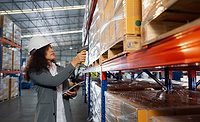Engineering R&D
GRL enables processors to track and trace product

LocatorX CEO Scott Fletcher



Imagine the ability to track a product anywhere in the world with accuracy of within one foot—less than 31 cm. Sounds impossible, but with technology that LocatorX is developing, it can be done. Established in 2014 by Billy Meadow, LocatorX is a new company dedicated to licensing and using solid-state atomic clock technology developed by the nanomaterials lab at the University of Oxford to build what the company calls a Global Resource Locator (GRL). This device—no bigger than the tip of a pencil—can be used with existing smartphones and cellular networks to track a product at any time anywhere in the world within reach of the network.
Not only can this technology reveal the precise location of a product, it can also—in conjunction with hardware-based encryption and blockchain technology—provide a complete record of a product’s travel from its source to the end user. Manufacturers know where their product is and who had it in their possession and for how long, which can practically eliminate the problem of food fraud/theft and ensure food safety along the supply chain.
GRL-enabled products, chips and labels will let food and beverage processors track and trace trucks, pallets, cases and individual products. And processors have complete control of chip operation throughout a product’s journey to the end customer.
CEO Scott Fletcher has more than 30 years’ experience with IT solutions and has assembled a team and board of directors with experience ranging from government and military to software development and nanofabrication. I spoke with him to learn more about LocatorX’s technology and where it’s going.
FE: GRL-enabled chips and labels are the third phase of an evolution of LocatorX’s tracking/tracing products. Could you describe this three-phase evolution?
Scott Fletcher: Phase 1 of this evolution features our smart label, which has advanced feature sets, including certificate authority, blockchain and unique identification. In Phase 2, we’ve embedded these labels with a microchip, so the product has similarities to an RFID label. We’ve combined two different communication formats in that one chip—near-field communication (NFC) and Bluetooth. And that has tremendous applications from a marketing perspective, as well as from the standpoint of supply chain/logistics/asset management across all industries—including agriculture, military and CPG. We are adding more advanced features in this phase, such as environmental sensors for humidity and temperature.
In the third phase, we’ll layer the solid-state miniature atomic clock into the Phase 2 chip to enable a powerful geo-positioning feature set that’s truly the foundation of IoT. Companies could apply this technology to an item in order to track and monitor its life cycle while connecting networked items on the smallest scale.
FE: What is your relationship with the University of Oxford?
Fletcher: Our Phase 3 GRL technology is powered by a solid-state miniature atomic clock, which is the first of its kind and patented by the University of Oxford. LocatorX holds exclusive rights to the technology for commercial purposes.
FE: How long have you been developing the GRL technology?
Fletcher: The University of Oxford invented the solid-state miniature atomic clock in 2012. We’re currently in the final engineering phase, where we’re perfecting our methods for adding our man-made molecules to the final step of silicon wafer manufacturing. The design will be used by our strategic licensing partners to create GRL-enabled devices of any type.
FE: Can you explain how GRL technology works?
Fletcher: The Global Resource Locator leverages the atomic clocks in terrestrial radio sources to self-locate inside and outside. When paired with IoT devices, it offers location accuracy without batteries. Where RFID technology requires proprietary systems to interface and operate, we work off of standard cell signals and the optical readers on smartphones. When you point your phone at one of our labels, it instantly brings up the reader.
FE: How is such a small device applied?
Fletcher: Our technology is embedded into what is the equivalent of a standard RFID label, in terms of size. These labels are part of the packaging. You can also apply them to packaging or shipping containers using an adhesive.
FE: On the IT side, how does the technology work?
Fletcher: On the IT side, we’ll have a set of standard APIs that we support. That way, IT teams across different industries can implement the technology in a way that integrates easily with existing platforms or systems. LocatorX has a developer toolset that supports this effort and allows for rapid rollout in the marketplace. And we’ll interface with any smartphone on the market. There’s no proprietary system required to interface with our technology.
The atomic clock is the most critical component in this satellite-based system. This technology is accurate to one one-billionth of a second. Everything else, including your wristwatch or a clock in your home, runs off of quartz-based timing—the accuracy of which is within one one-millionth of a second. When you’re calculating for distance, the atomic clock will deliver accuracy to within a foot while the quartz clock will deliver accuracy to within 1,000 feet.
FE: Track and trace is vital for food safety recalls. What about preventing food fraud? Have you been testing in other industries, e.g., pharma?
Fletcher: We have yet to test the product in the pharmaceutical industry; however, our smart labels can assist with the prevention of food fraud and the prevalence of counterfeit drugs in the marketplace. This solution gives brands insight as to where their assets are in real time and allows customers to verify authenticity prior to purchasing.
Using a smartphone, consumers can scan an item’s code, directing the browser to a verified and secure webpage. The certificate authority proves to consumers that the webpage and product are authentic, and that their personal information is secure. This is the only process that guarantees that customers are not purchasing a counterfeit product.
FE: You mentioned you’re working with a key food processor. How is the processor using the technology?
Fletcher: Our very first customer is one of the largest consumer packaged goods firms in the world, and they’re utilizing Phase 1, which doesn’t include communication, environmental sensors or geolocation capabilities. However, they are applying blockchain and unique identification, which assists with the prevention of counterfeiting, theft or diversion.
Our technology is helping this firm identify authenticity from the original source all the way down to the tables on which the food is served—which comes in handy, considering the frequency of recalls and the volume of foods that are mislabeled as organic or allergen-free. If a recall is ever issued, our solutions make management easier. We facilitate traceability down to the unit level, so this company can identify which area of the supply chain is impacted and recall specific units/cases/pallets, as opposed to entire production runs for long cycle times. That can translate to months or millions in losses, but it also damages consumer confidence. With our solutions, consumers can scan an item in their refrigerators to know whether it’s been recalled.
FE: When will this technology be available?
Fletcher: Phase 1 and Phase 2 are available. Phase 3 will launch in the first half of 2020.
FE: How would the cost compare with other technologies? Would it be used in tandem with other technologies?
Fletcher: Our Phase 1 smart label technology competes with barcodes. Because companies can use the printers they currently have, it costs next to nothing to print our unique certified QR codes.
Our Phase 2 technology competes with RFID. However, we believe that our technology will rapidly replace it. RFID launched two decades ago and, because it was costly and cumbersome, it was hard to get it to a price point that warranted the investment. While our product would be similar in price, we have feature sets that provide increased benefits, which would justify a slight bump in price compared to Phase 1.
While all three phases will work in tandem with other technologies, they do not require companies to invest in additional machinery.
For more information, visit www.locatorx.com
Looking for a reprint of this article?
From high-res PDFs to custom plaques, order your copy today!








